#music industry directory
Text
The Future of the Indian Film Industry: Trends and Predictions

Since it began, the Indian film industry, also known as Bollywood, has advanced significantly. The sector has undergone numerous changes due to its lengthy history and broad customer base. Several themes are anticipated to influence the future of the Indian film industry, from the rise of regional cinema to the impact of technology.
This piece will examine these patterns and offer forecasts for the industry's future. We will also discuss how the film distribution industry evolves and how globalisation affects Indian cinema. It would be interesting to see how these tendencies affect the Indian film business as it develops over the coming years with the Bollywood Directory.
The Development of Regional Film
The growth of regional cinema is one of the most important developments in the Indian film industry. Regional films are becoming more well-known and visible due to the development of digital media. More regional films can now be produced and distributed more widely thanks to the popularity of movies like KGF and Sairat. More regional films are anticipated to follow this trend in the coming years and earn popularity and acclaim.
New Talent's Development
Talented performers and directors have always been a hallmark of the Indian cinema industry. But new talent is entering the field due to the growth of digital platforms. With their distinctive storytelling and filmmaking abilities, many young filmmakers are making their mark in the industry. Future predictions indicate that this pattern will continue, with more fresh talent entering the market.
Influence of Technology
The Indian film business has been significantly impacted by technology. Filmmakers are experimenting with novel narratives and filmmaking due to the rise of digital media. In Indian movies, the use of VFX and CGI has increased, and this pattern is anticipated to last. The ability to reach a larger audience has also been facilitated by technology, and this trend is anticipated to persist in the future.
The Distribution of Film is Changing
The distribution of movies has evolved due to the emergence of digital channels. The practice of releasing movies exclusively on digital channels has become more popular after the COVID-19 pandemic. Future predictions indicate that more filmmakers will choose digital releases as a trend. The key question, particularly now that sales are split across streamers and box office tickets, is how filmmakers will recoup their costs.
As various streaming platforms play with how to release their selection of movies, business models for pricing are constantly changing. Filmmakers must adjust to this shifting environment of film distribution because audiences ultimately want to pick where and how they want to watch movies.
Globalisation's Effects on the Indian Film Industry
The distinctive storytelling and filmmaking techniques of the Indian cinema industry have long been renowned. However, as globalisation progresses, international films' effect on the Indian film industry grows. Future predictions indicate that there would be an increase in the number of Indian and international filmmaker partnerships. With movies like Baahubali and Dangal garnering popularity in China and other nations, the Indian film industry also extends its reach to foreign markets.
Conclusion
The Indian film business is a dynamic, ever-evolving sector that adapts to the times as they change. Some of the themes that are anticipated to have an impact on the future of the Indian film industry include the creation of regional cinema, cooperation between various film industries, the emergence of fresh talent, the impact of technology, the shifting landscape of film dispersion, and the impact of globalization.
A forum for Indian film aficionados to delve into the deep history and rich culture of Indian cinema is offered by the Bollywood industry app The Film India. The app details well-known Indian movies in several languages, including Hindi, Tamil, and Telugu. The app includes both Bollywood and the rising-in-status Bhojpuri film industry in addition to Bollywood. The Film India app is a one-stop shop for all Indian film industry aficionados to stay current on the newest trends and projections due to the growth of digital platforms.
#bollywood industry app#mumbai film industry app#indian music industry directory app#indian film industry app#bollywood actors and actresses film app#bhojpuri film industry app#a film app#marathi film industry app#film directory
0 notes
Text
The Bezzle excerpt (Part III)

I'm on tour with my new novel The Bezzle! Catch me TOMORROW in SALT LAKE CITY (Feb 21, Weller Book Works) and then SAN DIEGO (Feb 22, Mysterious Galaxy). After that, it's LA, Seattle, Portland, Phoenix and more!

This week, I'm serializing part of chapter 14 from my new novel The Bezzle, which is out in stores TODAY (!!!):
https://us.macmillan.com/books/9781250865878/thebezzle
The Bezzle is a Martin Hench novel, the followup to last year's Red Team Blues – though each book in the series is designed to be read in any order, and to stand alone (RTB just came out in paperback):
https://us.macmillan.com/books/9781250865854/redteamblues
Hench is a two-fisted, high-tech forensic accountant whose career spans 40 years of busting high-tech scams, from the earliest days of the PC to the white-hot center of the cryptocurrency bubble. Each book revolves around a single, central scam (in The Bezzle, it's the unbelievably slimy prison-tech industry):
https://pluralistic.net/2024/02/14/minnesota-nice/#shitty-technology-adoption-curve
But each book also features lots of subplots that unpick different kinds of fraud. In this serialized excerpt, we get to watch Marty unwind a music royalty theft scheme, the kind of thing that Rebecca Giblin and I pulled apart in our 2022 book, Chokepoint Capitalism (also now in paperback!):
https://chokepointcapitalism.com/
Today's installment gets into one of the major tactics of any semi-respectable scam – simply ignoring the victim in the hope that they'll get tired and go away. Any of us who've been ripped off by a big company can surely relate.
I'm leaving on my tour for this one tomorrow, starting with a gig in Salt Lake City at Weller Bookworks (Feb 21) at 630PM:
https://www.wellerbookworks.com/event/store-cory-doctorow-feb-21-630-pm
From there, it's on to LA (with Adam Conover), Seattle (with Neal Stephenson) and many, many more cities – maybe one near you!
https://pluralistic.net/2024/02/16/narrative-capitalism/#bezzle-tour
Here's part one of the serial:
https://pluralistic.net/2024/02/17/the-steve-soul-caper/#lead-singer-disease
And part two:
https://pluralistic.net/2024/02/19/crad-kilodney-was-an-outlier/#copyright-termination
And now, onto part three!

Stefon cooked Jamal another dinner and Jamal wrote another letter, this one more forceful, and addressed to Gounder by name. Two weeks later, Jamal wrote another letter without needing dinner because “that motherfucker went to Harvard fucking law”—Jamal had looked him up in the ALA directory—“and he knows you can’t make legal problems go away just by ignoring them. Time for that piece of shit to put on his big-boy pants and be a goddamned lawyer.”
The one thing Jamal wouldn’t do was file a lawsuit. “You need a lawyer for that,” he said. “I mean, I can help you with the paperwork, but a paralegal can’t file the suit. And you shouldn’t file your own suit, either. Those guys’ll just hire some blow-dried asshole from a big law firm and they’ll crush you like a cockroach.”
“Well, shit,” Stefon said. But it all made sense. Anyone doing business with Chuy Flores would do business like Chuy Flores—that is, crooked as hell.
“What you need is a contingency lawyer,” Jamal said. “Someone who’ll take the job for a piece of the action.” Which is how Stefon ended up being represented by Benny Caetani II, son of Benedetto Caetani, who graduated at the top of his Yale class, won a string of spectacular class-action suits, then got disbarred after someone leaked calls where he admitted moving money from one client trust account into another to cover a shortfall. No one seriously thought that Benedetto was stealing anyone’s money—he’d had receivables due within a week that let him make the trust account whole—but he was also clearly guilty.
Equally, no one seriously believed that the high-powered surveillance that led to Benedetto’s downfall was random. Benedetto had transferred more than a hundred million dollars from the balance sheets of America’s largest, dirtiest corporations— poison-peddling pharma giants, toxic-waste-dumping chemical companies, a global chain of botox parlors with some very loose syringes indeed—and they were gunning for him.
Officially, Benedetto was out of the lawyer game. Unofficially, he was the brains behind Benny, and the two of them ran a squeaky-clean shop, making sure that everything that an actual lawyer had to do, Benny did—while Benedetto did everything else. Father and son got along well and they were a hell of a team. When Benedetto called me in to audit Inglewood Jams’ books, I jumped at the opportunity. They were a delight to work for.
“They played tough,” Benedetto said, as his minions arranged the bankers’ boxes on the steel kitchen shelves he’d had installed on the long walls of the storefront he’d rented for me to work out of for the month. “At first. Told me they didn’t owe Stefon a dime, and that they’d rather bankrupt themselves in court than pay some broken-down, washed-up disco king anything. Told me his problem was with Chuy, not Inglewood Jams.”
“Well, to be fair, that Chuy guy sounds like a class-A piece of shit.”
“A broke piece of shit. Guy’s got a million-dollar nose and an empty bank account.”
“So you had to go after Inglewood Jams.”
Benedetto twirled around in his Aeron chair. He’d sent over a pair of them, asking if I needed more, because he had a storage locker full of them that he’d gotten as part of a settlement with a broke Santa Monica crowdsourcing company that stiffed its workers when it folded.
“I did. I went after them. That Gounder lawyer tried to bluff, then when that didn’t work, he tried to dodge service. Which was such a kindergarten move. Plus he was no good at it. Caught him outside the rub-and-tug parlor he went to every Friday after work. Handed him the papers. Wore a bodycam. Didn’t mention his wife. Didn’t have to.”
“You think he settled because he didn’t want his wife to find out he was getting hand jobs at a massage parlor?”
“No, he held out awhile after that. But I could see it preying on him, every time I was face-to-face with him. Eventually, he musta told his bosses that they were gonna lose, and so they offered a settlement. It was trash. I laughed in his face. He tossed out some better offers, but none of them even in the ballpark of what we would get in court. Finally, I told him to get serious or send his court suit out to the dry cleaner’s. That’s when he offered to make Stefon whole and pay me a little for my trouble on top of things.”
I suppressed a snort. I was sure that a little on top amounted to some real folding money.
“Even then he tried to pull a fast one, told me he’d calculate Stefon’s royalties and send a check the next week. I was like, ‘Hold up, there is no way you’re going to be able to make an honest accounting for Stefon’s royalties in a week. The dude’s samples are in hundreds of songs. The mere fact that you claimed that you could come up with a fair amount in a week tells me you were planning to pull a lowball number out of your ass and pass it off as the audited total, so tell you what, I’m gonna get the best forensic accountant in the state of California to come down here to LA and crawl all over your papers, and you are going to send him everything he needs to do it, or we’re going to court, motherfucker.”
“And he agreed?”
“Hell no. He refused. We went to a preliminary hearing. Judge turned out to be a classic soul fan. It didn’t go well for Gounder or Inglewood. The next day, he was back in my office, and now, well, here we are.”
ETA: Here's part four!

If you'd like an essay-formatted version of this post to read or share, here's a link to it on pluralistic.net, my surveillance-free, ad-free, tracker-free blog:
https://pluralistic.net/2024/02/20/fore/#lawyer-up
#pluralistic#the bezzle#martin hench#marty hench#red team blues#fiction#crime fiction#crime thrillers#thrillers#technothrillers#novels#books#royalties#wage theft#creative labor
10 notes
·
View notes
Text

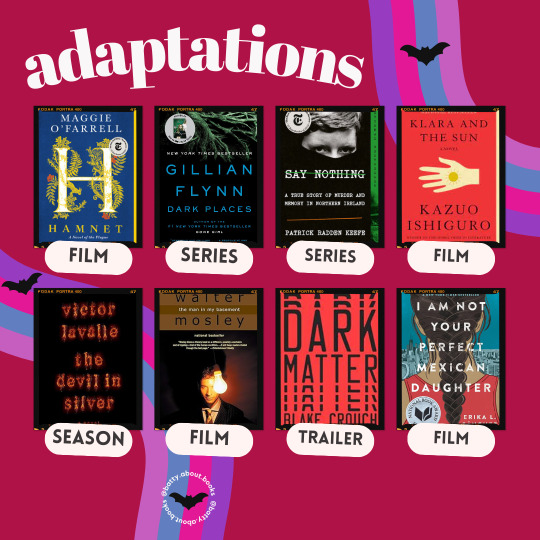





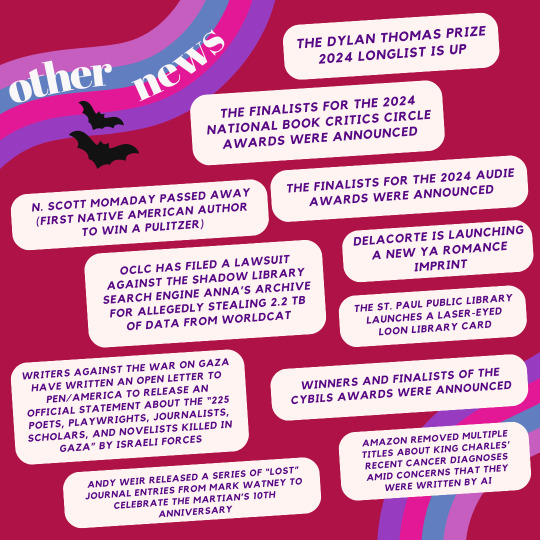

🗞️📖 Bookish News - February Edition
🦇 Extra, extra. Read all about it!
📖 Good evening, bookish bats! A lot happened in the publishing industry this month, but here are a few highlights you may have missed! Check below the cut for details.
Adaptations:
🗞️ Chloé Zhao will direct a film adaptation of Hamnet (Maggie O'Farrell) starring Jessie Buckley and Paul Mescal
📖 HBO is adapting Dark Places (Gillian Flynn) as a limited series. Flynn will serve as co-creator, writer, and co-showrunner
🗞️ FX has ordered a limited series adaptation of Say Nothing (Patrick Radden Keefe), directed by Michael Lennox
📖 Taika Waititi will direct an adaptation of Klara and the Sun (Kazuo Ishiguro), potentially starring Amy Adams and Jenna Ortega
🗞️ The Terror will base season 3 on The Devil in Silver (Victor LaValle)
📖 The Man in My Basement (Walter Mosley), directed by Nadia Latif, will star Anna Diop, Corey Hawkins, and Willem Dafoe
🗞️ Dark Matter (Blake Crouch) has a trailer
📖 America Ferrera's feature directorial debut for I Am Not Your Perfect Mexican Daughter (Erika Sánchez) is in development
🗞️ The adaptation of Turtles All the Way Down (John Green) will stream on MAX this year
📖 Hook’s Daughter: The Pirate Princess Chronicles (R. V. Bowman) is getting a live-action adaptation
🗞️ Interview with the Vampire (based on Anne Rice's novel) is getting a second season
📖 Percy Jackson and the Olympians is getting a second season
🗞️ Seven Days in June (Tia Williams) is being adapted for Prime Video
📖 The adaptation of A Gentleman in Moscow, (Amor Towles) will star Ewan McGregor
🗞️ The Color Purple movie musical will stream on MAX (Feb. 16)
📖 Hulu’s adaptation of A Court of Thorns and Roses was axed
🗞️ The Alex Van Helsing YA books are being adapted for a television series
📖 Ryan Reynolds and Paramount are working on an adaptation of Starter Villain (John Scalzi)
🗞️ A Short History of Nearly Everything (Bill Bryson) will be adapted as an animated TV series
📖 The trailer for the film adaptation of Wicked is up
🗞️ Netflix renewed Survival of the Thickest for season 2
📖 The cast for Marvel’s Fantastic Four has been announced (July 25, 2025)
🗞️ The trailer for the new X-Men animated series is up (Mar. 20)
📖 The Oscar-nominated animated film Nimona is now available to watch for free on YouTube!
🗞️ Reese Witherspoon is producing a film adaptation of Romantic Comedy (Curtis Sittenfeld)
📖 Photos are up for the adaptation of A Good Girl’s Guide to Murder (Holly Jackson)
Cover Reveals:
🗞️ When Haru Was Here - Dustin Thao (Sept. 3)
📖 Trick or Treat on Scary Street - Lance Bass (July 23)
🗞️ The Bletchley Riddle - Ruta Sepetys and Steve Sheinkin (Oct. 8)
📖 The Rules of Royalty - Cale Dietrich (Dec. 10)
🗞️ Colored Television - Danzy Senna (July 30)
📖 Bits and Pieces: My Mother, My Brother, and Me - Whoopie Goldberg (May 7)
🗞️ House of Bone and Rain - Gabino Iglesias (Aug. 6)
📖 Rani Choudhury Must Die - Adiba Jaigirdar (Nov. 12)
🗞️ Night Owls - A.R. Vishny (Sept. 17)
📖 The Dixon Rule - Elle Kennedy (May 14)
🗞️ A Bánh Mì for Two - Trinity Nguyen (Aug. 27)
📖 The Hitchcock Hotel - Stephanie Wrobel (Sept. 24)
🗞️ In Want of a Suspect - Tirzah Price (Nov. 12)
📖 Memorials - Richard Chizmar (Oct. 22)
🗞️ The Empusium - Olga Tokarczuk (Sept. 24)
📖 Unsinkable Cayenne - Jessica Vitalis (Oct. 29)
🗞️ Cue the Sun! - Emily Nussbaum (June 25)
📖 We're Alone - Edwidge Danticat (Sept. 3)
🗞️ The Sherlock Society - James Ponti (Sept. 3)
📖 The Enchanted Hacienda by J.C. Cervantes (May 21)
🗞️ The Baby-sitters Club: Kristy and the Walking Disaster - Ellen T. Crenshaw (Sept.)
📖 The Baby-sitters Litter Sister: Karen’s Grandmothers - DK Yingst (Oct.)
🗞️ The Millicent Quibb School of Etiquette for Young Ladies of Mad Science - Kate McKinnon (Oct. 1)
📖 The Life Impossible - Matt Haig (Sept. 3)
🗞️ Ruin Road - Lamar Giles (Sept.)
📖 Yours Truly by Katie Shepard (Sept. 3)
🗞️ Wishbone - Justine Pucella Winan (Sep. 17)
📖 Haunt Your Heart Out - Amber Roberts (Oct. 8)
🗞️ The Dividing Sky - Jill Tew (Oct. 8)
📖 Heir - Sabaa Tahir (Oct. 1)
🗞️ Beautiful Dreamers - Minrose Gwin (Aug. 27)
📖 We Solve Murders - Richard Osman (Fall)
🗞️ Till the Last Beat of My Heart - Louangie Bou-Montes (Sept. 10)
📖 Aisle Nine by Ian X (Sept. 24)
🗞️ Warrior of Legend - Kendare Blake (Sept. 17)
📖 The Ancient’s Game - Loni Crittenden (Oct. 29)
🗞️ The Witch of Wol Sin Lake - Lega Jeong (Oct. 29)
Upcoming Releases:
🗞️ Tiny Reparations Books has secured North American rights to two new books by National Book Award–longlisted author LaToya Watkins. The first book, The Book of Chuck, will be published in spring 2026.
📖 Tia Williams has sold North American rights to two new novels to Grand Central.
🗞️ LeVar Burton is releasing two new books
Other News:
🗞️ The Dylan Thomas Prize 2024 longlist is up
📖 The finalists for the 2024 National Book Critics Circle Awards were announced
🗞️ The finalists for the 2024 Audie Awards were announced
📖 Pulitzer-winning author N. Scott Momaday passed away (first Native American author to win a Pulitzer)
🗞️ OCLC has filed a lawsuit against the shadow library search engine Anna’s Archive for allegedly stealing 2.2 TB of data from WorldCat
📖 The St. Paul Public Library launched a laser-eyed loon library card
🗞️ Writers Against the War on Gaza have written an open letter to PEN/America to release an official statement about the “225 poets, playwrights, journalists, scholars, and novelists killed in Gaza” by Israeli forces
📖 Andy Weir released a series of “lost” journal entries from Mark Watney to celebrate The Martian’s 10th anniversary
🗞️ Amazon removed multiple titles about King Charles’ recent cancer diagnoses amid concerns that they were written by AI
📖 This year’s winners and finalists of the Cybils Awards were announced
🗞️ Delacorte is launching a new YA romance imprint
#books#books to read#book adaptation#book news#book publishing#publishing#book covers#batty about books#battyaboutbooks
5 notes
·
View notes
Text
Interview – A Midsummer Night’s Dream director Eleanor Rhode talks technology and Wonka star Mathew Baynton
Aiming to take the chill off this winter is the RSC’s new production of A Midsummer Night’s Dream. Ahead of the opening this week, director Eleanor Rhode spoke to Gill Oliver about her take on the Dream and what it’s like working with Wonka star Mathew Baynton.
TECHNOLOGY combined with centuries-old stage illusions are making one of the Bard’s most captivating comedies even more magical.
The RSC’s production of A Midsummer Night’s Dream, which opened on Tuesday for an eight-week run, features Ghosts and Wonka star Mathew Baynton as Bottom.
Fresh from his roles as a murderous doctor in the Agatha Christie TV series Murder Is Easy, and an evil chocolatier in hit movie Wonka, Baynton has long been a hero to parents and kids everywhere thanks to his leading role in five series of hugely successful kids’ comedy TV sketch show Horrible Histories and later, its spin-off ‘Bill’, a panto-style take on Shakespeare’s early life.
Also in the cast are Nicholas Armfield as Demetrius, Sirine Saba as Titania and Rosie Sheehy as Puck.

The equally prestigious creative team line-up includes composer Will Gregory (one half of electronic music duo Goldfrapp), set designer Lucy Osborne and illusion direction and designer John Bulleid, feted for his work on Harry Potter and the Cursed Child and the RSC’s The Magician’s Elephant.
Weaving all these star-studded strands together is director Eleanor Rhode, who describes Baynton as “an absolute genius” and the whole cast as “amazing”.
Ms Rhode made her directorial debut for the RSC in 2019 with a radical re-telling of King John – a production that was cut short due to Covid.
Now back to take on Midsummer’s Night Dream she’s happy to be back in Stratford.
“The company is wonderful, and everyone is working together brilliantly so it’s very exciting to be back up here - it’s a lovely place to work," she said.
She brings a fresh and confident vision to Shakespeare’s popular tale of four young lovers who, faced with the prospect of unhappy marriage flee the court of Athens and stumble into an enchanted forest.
Nearby, a group of amateur actors rehearse a play to celebrate an upcoming royal wedding and when the mortals cross paths with a warring fairy King and Queen, chaos erupts as the real and fairy worlds collide.
Ms Rhode explained: “The thing that’s always interested me more than a literal forest is leaning into the dream of a Midsummer’s Night Dream, so this is very much a dream space.
“The most exciting thing is finding that crossover between contemporary technology and stage illusions and stage tricks that are hundreds of years old, so expect to see a lot of those things combined.”
By the RSC’s standards the production is a short run but there are upsides to this.
“It means some of the people who would love to come and work up here but can’t commit to a year away from the other projects they’re doing, can come, have a really lovely time and be up here for 10-weeks - we wouldn’t necessarily be able to get them for longer, so that’s enormously gratifying,” she pointed out.

After this run, Ms Rhode, who has a decade's experience of directing, will spend time in developmental workshops before overseeing her second audio play for release on Audible.
She enjoys working in other mediums such as audio, and is excited by the potential that comes with the “pollination of ideas between lots of different disciplines”.
But unlike the RSC, the theatre industry overall tends to be extremely traditional and not geared-up for sweeping change.
She explained: “In terms of creating experiences which are live but also digital at the same time and which have a really broad reach in terms of the audiences, you’re engaging with people who aren’t traditional theatre goers and really broadening the scope of what live story telling can be.
“There’s a whole heap of possibilities and the lovely thing is that a lot of the technology is already there - the technology isn’t the thing - it’s actually the ability to craft brilliant storytelling entwined with the technology that’s sometimes quite scary.”
As for this production of Midsummer Night’s Dream, no one should worry about technology or stage illusions over-shadowing or interfering with the intimacy of live performance.
“You shouldn’t notice the technology and it shouldn’t feel like a standalone thing, in the same way that stage illusions shouldn’t – everything is entwined with the story,” she said.
“My hope is that it’s something the audience don’t really think about, they just enjoy it.”

She added: “This production is already looking beautiful but it should also be very surprising and, hopefully, keep the audience on their toes with all the amazing magic that’s going on in the show.
“Regardless of that, strip away all the technological and magical surprises and the play is the thing.
“It’s a brilliant show with brilliant actors in it - that’s the key thing."
#stratford herald#eleanor rhode#mathew baynton#mat baynton#a midsummer night's dream#a midsummer nights dream#midsummer night's dream#amnd#rsc#royal shakespeare company#was debating putting his name in the tags but he got a mention in the title and in the interview so#also#did the interviewer not do their research? “murderous doctor”?? i think they've gotten a little bit confused#anyway a lovely read and i had to pay for this loool. getting rid of this free month trial asap#rj: interview#rj: a midsummer night's dream#rj: 2024
5 notes
·
View notes
Text
Barry Hertz’s article reproduced below:
There is a strong case to be made that Norman Jewison was the most important Canadian filmmaker to never make Canadian films.
A child of Toronto but a creature of Hollywood, Jewison, who died Saturday at the age of 97, built his directorial career outside his beloved home country from almost the very beginning. A stint at the BBC in London turned into a few years at the CBC, which led to gigs inside American network television, which in turn allowed him to wriggle himself inside, and then more or less conquer, the studio system.
Did Jewison consider himself “Canadian” as he made every kind of film under the L.A. sun?
In 24 features produced across five rollicking decades of industry excess, was there some kind of homegrown thread that could connect everything from a fizzy heist flick (1968′s The Thomas Crown Affair) to go-for-broke musicals (1971′s Fiddler on the Roof, 1973′s Jesus Christ Superstar) to a stirring legal drama (1979′s ... And Justice for All) to a screwball rom-com (1987′s Moonstruck)?
Perhaps the answer can be found in Jewison’s intense commitment to social justice – his unshakable belief that filmmaking not only had the power but also the duty to change the way that we see our world, and each other. That is as admirably progressive a Canadian value as anything, and can be felt powering Jewison’s most searing productions, including 1967′s In the Heat of the Night, 1984′s A Soldier’s Story, 1999′s The Hurricane, and even, in its own way, his wild 1966 farce The Russians Are Coming, The Russians Are Coming!
But despite setting one film in Montreal (1985′s Jane Fonda convent drama Agnes of God) and half of another in Toronto (The Hurricane), Jewison never made the Great Canadian Film. Not that he didn’t want to.
“I wish I could have made a statement about Canada vs. the U.S., and Canada vs. the rest of the world. I would have loved to do it. But I never found a story that I believed I could make into an exciting motion picture,” Jewison told The Globe and Mail in 2016. “If you set out to make a big statement about Canada, you’re going to fail!”
While Canadian filmmakers – both Jewison’s contemporaries and those who followed him decades afterward – might disagree with such a statement, one thing becomes clear when considering the director’s improbable, eclectic and essential canon: Norman Jewison never, ever wanted to fail. While he may have stumbled here and there, disaster was flirted with more than tolerated. If there is one through-line to Jewison’s films, it is the fierce commitment to the belief that a good story told in a highly entertaining fashion – slick, precise, sincere – is the very best way to win hearts and minds. Give it your all, and audiences will respond in kind.
Sometimes this worked out better in theory than practice – few contemporary moviegoers will find much to revisit in 1982′s Best Friends, 1994′s Only You or 1996′s Bogus – but when Jewison was able to line up his passions and resources just so, it resulted in a kind of beautiful cinematic alchemy. He wrung tremendous performances from Hollywood legends (Steve McQueen, Sidney Poitier, Al Pacino), uncovered new layers in superstars who audiences thought they already knew inside out (Cher), minted new stars (Nicolas Cage, Denzel Washington), and made it all seem so deceptively easy.
Even Jewison’s missteps contained such endlessly fascinating elements – the distressingly prescient corporate satire of Rollerball, the labour politics of F.I.S.T., the lingering political ambiguity of what would be his final film, The Statement – that they all demand attention and reassessment. Jewison was a relentlessly committed craftsman who worked in the service of the audience. He was Canada’s ultimate showman, even if he didn’t believe he could ever show Canada to the rest of the world.
Not to say that Jewison ever forgot where he came from, either.
As founder of the Canadian Film Centre, a charitable organization that has helped train 1,900-plus filmmakers, writers and performers since its inception in 1988, Jewison played an integral role in building up this country’s screens sector. It was a community that Jewison himself never relied upon to build his own career – but only because it was a community that simply did not exist at the time.
And what is more Canadian than helping others, even if you were never given the same opportunity yourself?
#rip norman jewison#norman jewison#barry hertz#the globe and mail#canadian directors#canadian film centre#canadian film#canadian cinema
5 notes
·
View notes
Text

Music to Our Ears with Adam Anders Pt. 1
Calling all Gleeks, you're in for a big treat! Joining the pod is writer, director, and Grammy-nominated music producer Adam Anders, who has sold over 100 million records and has worked with some of the biggest names in the recording industry . . . including the cast of Glee! Glee's Executive Music Producer shares never-before-heard stories with Kevin and Jenna, like his terrible first meeting with Ryan Murphy, what song he and Ryan fought over (and who won), the tune that gave him goosebumps as they were recording it, and the intense process of making songs for the show! Plus, Adam is making his directorial debut with "Journey to Bethlehem," hitting theaters on November 10th with songs written by the Glee team!
8 notes
·
View notes
Photo



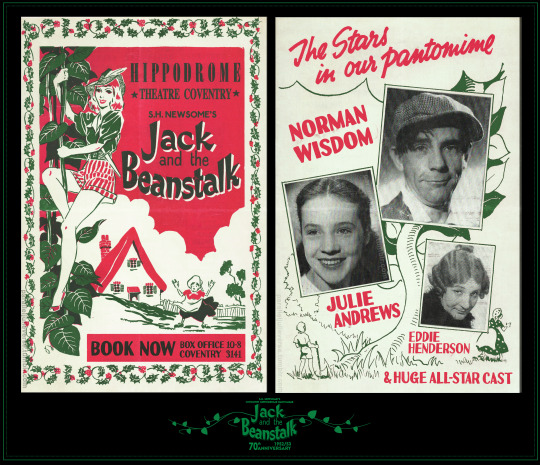
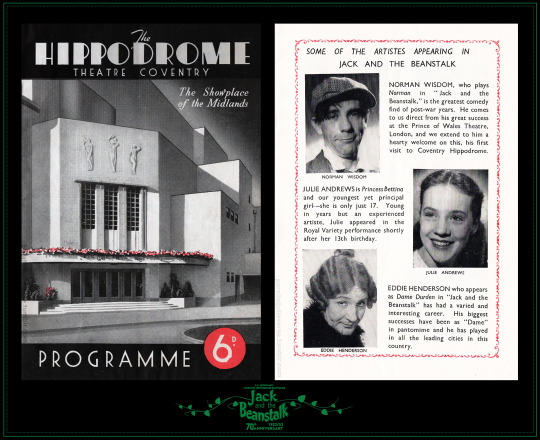



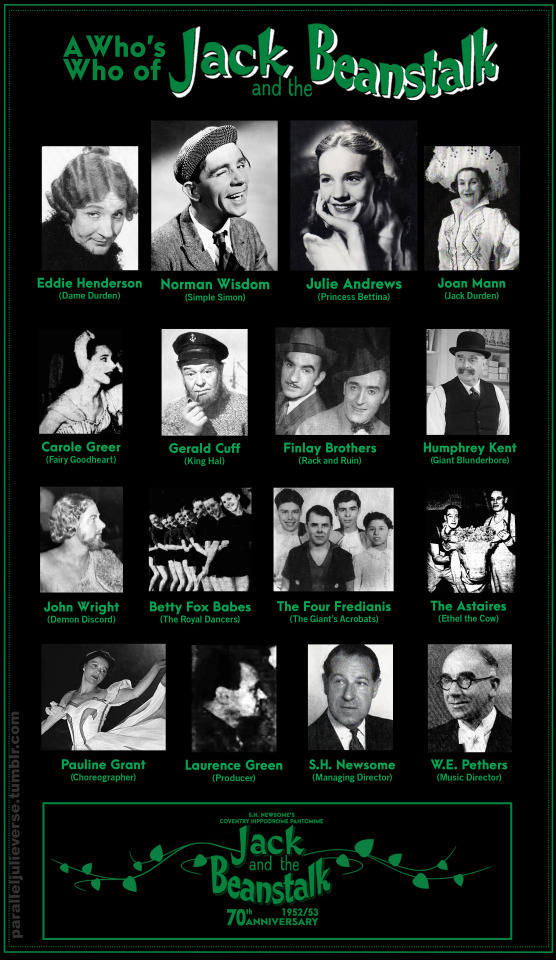
70th anniversary of Jack and the Beanstalk
Coventry Hippodrome, 164 performances
(23 December 1952 - 28 March 1953)
This week marks the 70th anniversary of a milestone event in the juvenile career of Julie Andrews: the opening of Jack and the Beanstalk at the Coventry Hippodrome on 23 December 1952. It would be Julie’s fourth annual pantomime, following Humpty Dumpty (1948), Red Riding Hood (1950) and Aladdin (1951).
That Jack and the Beanstalk was a provincial production -- rather than a West End show -- could be misconstrued as a career comedown for the young star. After all, twelve months earlier she was principal girl in Aladdin at the London Casino and the following year she would headline the 1953 production of Cinderella at the London Palladium. But an appearance at the Coventry Hippodrome was no small affair.
The Showplace of the Midlands
Dubbed “The Showplace of the Midlands”, the Hippodrome was an ultra-modern Art Deco entertainment palace lovingly built and managed by automobile industry baron cum entertainment impresario, Sam Newsome. With a massive 2000-seat auditorium, multi-levelled foyers and bars, twelve dressing rooms and its own broadcasting studio, the Hippodrome occupied over one and a quarter acres in the heart of Coventry. It was the biggest and most up-to-date theatre in the country -- and it quickly established itself as the foremost Midlands venue for touring dates, attracting a stream of headline acts and hosting regular seasons from major companies including The D'Oyly Carte Opera and Sadler’s Wells Opera (Newman 1995).
The Coventry Hippodrome was especially celebrated for its spectacular Christmas pantomimes. Newsome took “personal pride and delight in his pantomimes” and ensured they “possessed a thoroughly exclusive quality” that distinguished them from run-of-the-mill seasonal fare (Stephens 1965, 6). Planning for each year’s panto would start months in advance with generous budgets, top-notch creative talent, high production values, and big star names.
It was a calculated business strategy on Newsome’s part. Not only would each Christmas panto be an assured money-earner for his theatre, but, once it had debuted in Coventry, it would subsequently be re-mounted -- using the same scripts, sets, costumes and, sometimes, cast members -- in other theatres. It was not uncommon for a different Newsome pantomime to be playing simultaneously in five or six theatres around the country (Auty, 20; Newman, 77). In the case of Jack and the Beanstalk, for example, Newsome would re-stage the show repeatedly over ensuing years including runs at the Dudley Hippodrome in 1953/54; the Derby Hippodrome in 55/56; the Swansea Empire in 56/57; the Brighton Hippodrome in 57/58 and the Bradford Alhambra in 59/60 (The Stage).
Launching Jack and the Beanstalk
In early 1952, Newsome announced that his next Christmas pantomime at the Coventry Hippodrome would be an “entirely new and magnificent production” of Jack and the Beanstalk, a popular source for pantos since the early-19th century and a sure-fire crowd pleaser. A “firm believer in maintaining the well-loved traditional features of Pantomime”, Newsome’s production of Jack adhered faithfully to the plot of the well-known fairy tale about the adventurous village lad turned Giantslayer, but with lashings of pantomime essentials of music, spectacle, comedy and dance. (Newsome: 1).
Overseeing the production and taking on directorial duties was Laurence Green, something of a right-hand man for Newsome throughout this era. The book was developed by the celebrated lyricist team, Barbara Gordon and Basil Thomas, who were also Newsome panto regulars. Other key members of the production team included costume designer, Michael Bronze, and set designers, Josef Carl and Tod Kingman, who created a series of impressive backdrops and props including a giant hand that in one scene whisked Julie aloft into the theatre fly tower (Foxon: 6; Whetsone: 3).
In terms of music and dance, there were seventeen full musical numbers with a mix of classics, pop standards, and bespoke compositions, all arranged and orchestrated by the Hippodrome’s longtime music director, W.E. Pethers. Celebrated choreographer, Pauline Grant was commissioned to develop several dance routines including an Act 1 closing ballet sequence and a grand finale parade.*
As always, one of the most important elements in the show was its roster of on-stage talent. And for Jack and the Beanstalk, Newsome assembled a star-studded line-up from the fields of theatre, variety, film, and dance. To optimise marketing potential, the principal cast was announced in June, a full six months before the show was set to open. Julie was cast in the principal girl role of Princess Bettina, alongside Joan Mann as Jack; Eddie Henderson as Dame Durden; and, the undoubted comic star of the show, Norman Wisdom as Simple Simon (‘Norman Wisdom to star’: 6).
Stories and profiles about the stars were fed in regular instalments to the local and regional press, ensuring continued exposure and boosting public anticipation (’Pantomime Star’: 4; ‘Julie is so determined’: 6). Julie even made a ‘surprise’ PR visit to Coventry in the first week of November to join the theatre’s special Birthday Show (‘Behind the footlights’: 9). The star-driven marketing paid off handsomely with brisk ticket sales. By early-December, a quarter of a millions seats had been booked -- a theatre record -- and the run was extended from 12 to 14 weeks (’Quarter of a million...”: 4).
The Singing Princess
Though she would be second fiddle to the show’s top billed player, Norman Wisdom, Julie was an important drawcard for Jack and the Beanstalk. Much was made of her youth and the fact that, at just seventeen, she was the youngest principal girl ever to appear in a Newsome pantomime (’Pantomime Star’: 4; ‘Julie is so determined’: 6).
And, as John Cottrell (1968) notes, “[f]or the first time in her life she was treated like a star” (62). She was given one of the theatre’s best dressing rooms with its own private bathroom -- and Newsome made sure that it was decked out with fresh flowers each week, even during rehearsals (Andrews: 146; Cottrell: 61).
Julie also commanded a star-like fee, securing a contract for a whopping £250 per week, reported to be an era record for a pantomime principal girl (Cottrell: 61). It was a burst of newfound wealth that allowed the young star to buy her first car -- which she dubbed ‘Bettina” in honour of the character she played in the show -- and assume control from her parents of the mortgage on ‘The Old Meuse’, the family home in Walton (Andrews: 147).
As Princess Bettina, the object of Jack’s affection who is rescued by the young hero and united with him in the mandatory happily-ever-after finale, Julie had one of her biggest stage roles to date. Combining moments of royal pageantry, abduction and imprisonment, thrilling rescue, and budding romance, the script afforded an opportunity for the young actress to flex her growing dramatic talents.
Needless to say, Jack and the Beanstalk also showcased Julie’s most famous asset: her voice. She was given six full musical numbers in the show -- four solos and two duets -- comprised of:
‘If You Feel Like Singing’: This popular Warren-Gordon song had only recently been introduced in the 1950 MGM film, Summer Stock, where it was performed by Judy Garland (Larkin 1992). In the show, Julie sings the number in Scene 1 as her character is wandering alone in the forest and is spied by Jack who instantly falls in love wth her. With its lyrical ode to expressive singing and repetitive tra-la-las, the song would have provided a perfect showcase for Julie’s brand of light coloratura trilling.
‘Am I in Love’: Another newly-minted Hollywood number, this Oscar-nominated song by Jack Brooks was first performed by Bob Hope and Jane Russell in the 1952 Paramount release, Son of Paleface (Benjamin and Rosenblatt 1993). In the show, Julie sings it in Act 1 as a duet with Jack (Joan Mann) and reprises it again a few scenes later as a solo.
‘You Made Me Love You’: This well-known pop standard by Monaco and McCarthy was first performed by Al Jolson in 1913. It quickly became an international hit and part of the Great American Songbook, covered by a wide variety of famous vocalists including Jeanette MacDonald, Bing Crosby, Doris Day and, in a slightly revised version, Judy Garland in The Broadway Melody of 1938 (Whitburn 1986). In the show, Julie sings it in Act 1 as a duet with Norman Wisdom in the comic star role of Jack’s bumbling younger brother.
‘Yesterdays’: This classic ode to lost loves from the 1933 Kern and Harbach musical Roberta has been performed by many singers over the years including Irene Dunne, Mario Lanza, Barbra Streisand and Kiri Te Kanawa (Larkin 1992). One can only imagine how lovely Julie’s version would have been, sung as the imprisoned Princess pines for her home at the start of Act 2.
‘The Belle of the Ball’: Written in traditional Viennese style, this bouncy LeRoy Anderson waltz was introduced in 1951 and quickly became a light classical standard that has been played over the years by countless pop orchestras and school bands. It also has a lesser known sung version with lyrics by Mitchell Parish (Whorf 2012). It is that version that Julie performed in the show as her final solo. Hippodrome music director W.E. Pethers clearly liked LeRoy Anderson because Jack and the Beanstalk featured another of the composer’s orchestral works, ‘The Syncopated Clock’, used for the opening dance in Act 2.
‘You Belong to Me’: This romantic ballad was another newly-minted hit in 1952. First recorded by Joni James, it was made famous by Jo Stafford in a chart-topping single that became an international sensation. With its lilting melody and evocative opening lyric -- “See the pyramids along the Nile...” -- it became one the era’s most popular love songs and was recorded by many of the biggest vocalists of the 1950s such as Ella Fitzgerald, Patti Page, Dean Martin and, in the UK, Alma Cogan (Larkin 1992). The song was used in Jack and the Beanstalk as the final love duet between Jack and Princess Bettina.
A Who’s Who of Jack and the Beanstalk
Alongside our Julie, other key talents involved in the cast of Jack and the Beanstalk included:
Norman Wisdom as Simple Simon: The beloved 'sentimental clown’ of British theatre, film and television, Wisdom shot to meteoric fame in the late-40s and early-50s with an appealing brand of character-based physical comedy. Sporting a trademark crumpled suit and upturned tweed flatcap, he crafted an endearing persona nicknamed "The Gump," a well-meaning, bumbling Everyman who failed at everything but won hearts in the process. A talented musician and vocalist, Wisdom included songs as a central part of his act which he would use to great effect in accentuating the warm-hearted pathos of his comedy (Bullar and Evans: 186).
As with many stage performers of the era, Wisdom made frequent forays into pantomime, starting with a well-received debut in Robinson Crusoe at the Alexandra Theatre Birmingham in in 1948/49. By the time of Jack and the Beanstalk, Wisdom was a major star and the show gave him free rein in several set pieces including five songs, three of which he wrote himself. In his memoirs, Wisdom (2002) fondly recalled his time in the show, making special mention of Julie who, he writes, “had a freshness about her that was totally captivating” (181).
Following Jack, Wisdom went on to an even bigger career in film with a string of hit comedies for Rank that saw him become one of the most popular stars of British cinema of the 50s and early-60s. Though his style of sentimental slapstick would fall out of fashion, Wisdom remained a much-loved national icon. In recognition of his contributions to British cultural life, he was knighted by the Queen in 2000. He passed away in 2010 at the grand age of 95 (’Sir Norman Wisdom’: 29).
Eddie Henderson as Dame Durden: Though he is little remembered today, Scots-born Henderson was a popular figure of mid-century British theatre and variety. A self-taught dancer and comic actor, Henderson had a diverse career that stretched across music hall, cabaret and ‘legitimate theatre’. In the inter-war years, he toured widely in revues and productions around the UK and abroad. He played opposite a young Ronald Colman and even co-wrote a play with Reginald Furdell (Ashley: 2). Henderson was especially renowned as an accomplished panto Dame. He played a long line of comic Dames from the 1930s into the early-60s, earning him the soubriquet “Queen of Dames” (Durbridge: 5). Jack and the Beanstalk would be the first of several pantomimes that Henderson would do for Newsome during the 1950s, before retiring in the early-60s.
Joan Mann as Jack: Welsh-born Mann trained as a dancer and started touring the variety circuit in her teens where she appeared on bills with stars including Max Miller and Tommy Trinder. A tall attractive brunette with a pleasant voice and shapely dancer’s legs, Mann was a perfect pantomime boy. She played in top pantos in Glasgow, Edinburgh, and Liverpool, before making her Coventry debut in Jack and the Beanstalk. Julie relates in her memoirs that she and Mann roomed together during the run of Jack and, despite a 15-year age difference, they became firm friends. Mann would re-team with Julie in 1953 as part of the musical revue, ‘Cap and Belles’ (Andrews: 146).
Mann’s greatest fame came as part of the celebrated Fols-de-Rols variety troupe with whom she performed for almost two decades. She also starred opposite Dame Anna Neagle in the hit West End musical, Charlie Girl in the late-1960s. Mann died in 2007 aged 87 (P.N.: 53).
Finlay Brothers as Rack and Ruin (The Broker’s Men): One of the many novelty acts popular in mid-century variety, the Finlay Brothers started as a comic musical trio in the late-30s. Billed as “the English replies to the American Marx Brothers”, they blended song, dance, slapstick, sketch comedy and vocal impressions into a fast-paced routine (’What’s On’: 10). When one of the brothers called it quits following the war, Jack and Herbie Finlay continued as a duo, using a classic straight man/clown pairing. One brother would try to sing and act dramatically but the other would forever interrupt with ludicrous gestures and facial expressions, setting the scene for a manic spectacle of physical comedy. It played well in the era and, come Christmastime, the Finlay Brothers would be in demand as comic supports for panto. In Jack and the Beanstalk, they played the comic duo part of the Chancellor’s bumbling officials with much opportunity for audience-pleasing slapstick. The Finlay Brothers continued variety touring and Christmas pantos into the late-50s before retiring (’Pantos last’: 4).
The Four Fredianis as the Giant’s Acrobats: Part of a multigenerational lineage of Italian circus performers dating back to the 17th century, the Four Fredianis was a family group of acrobats comprised of father, Giovanni, and his three sons, Rolando, Guglielmo, and Bruno (Cochran: 38). Giovanni had grown up performing in his own father’s circus troupe in Europe before branching out on his own. He settled in the UK where the Four Fredianis moved from circus work into the more stable and lucrative field of variety and theatre. In fact, the Fredianis shared an earlier variety bill with Julie as part of the Look In revue which toured through the spring of 1952 (‘At the Theatre: 4). In Jack and the Beanstalk, they were cast as ‘The Giant’s Acrobats’ encountered by Jack on his way to the Giant’s castle, but their role was essentially to bring increased spectacle and physical excitement to the show’s proceedings.
Gerald Cuff as King Hal: Playing the part of Princess Bettina’s ‘merry monarch’ father, Gerald Cuff started his career in repertory where he performed for many years as part of the celebrated Derek Salberg Company in Wolverhampton (’Personality’: 13). During out-of-season spells he would appear frequently in pantos, many of them for Sam Newsome. In fact, he would reprise his role as King Hal in the Dudley Hippodrome season of Jack and the Beanstalk the following year (B.M.: 6). Cuff’s lasting claim to fame came in 1958 when he was cast as ‘The Bosun’ in the popular British TV series of Popeye (Ashley, R.: 20). In his spare time, Cuff was a publican in his hometown of Wolverhampton. He died in 1963 at the sadly young age of 58 (’Obituary’: 7).
Carole Greer as Fairy Goodheart: Trained as a ballet dancer from childhood, Scottish-born Greer started her theatrical career at age 16 when she first appeared in pantomime during school holidays. She then toured the variety circuit for a few years as part of a dance duo with Barrie Manning. Greer was subsequently championed by choreographer, Pauline Grant, who cast her as principal dancer is several shows, including Jack and the Beanstalk (Thespis: 9). She appeared for two seasons with the Gyndebourne Opera Company, including a tour of Germany (’Flying opera’: 5). She also performed in a few London shows, notably Fun and the Fair at the Palladium in 1953. Like others in the cast, Greer would reprise her role as Fairy Goodheart in the Dudley Hippodrome season of Jack and the Beanstalk the following year (B.M.: 6). Thereafter, the public trail for Greer grows cold. Like many women of that era, she may have married and changed her name and/or possibly retired from the stage.
Humphrey Kent as Giant Blunderbore: Born in Hertfordshire, Kent was a regular in regional theatre throughout the 40s and 50s. He had an early success as part of the cast of the touring production of Lesley Storm’s Great Day in the mid-40s. Thereafter he seemed to settle in to a steady stream of local productions with the occasional brief appearance in film and TV. He did some film voicework including working with Julie on the British dubbed version of the Italian animated feature, The Rose of Barghdad (1952) where he voiced the part of Tonko (’Rose’:43). A tall, well-built man with a booming voice, Humphrey was ideal for the part of the Giant, a role he would reprise several times over the years (’Panto Giant’: 9).
John C. Wright as Demon Discord: Born in Northampton, Wright studied at the Repertory Theatre where he appeared opposite Sonia Dresdel and Freda Jackson. A classically trained tenor, he performed widely in opera and musicals in the interwar years, including several seasons with the Carl Rosa and Sadler's Wells Opera Companies. After the war, Wright went on to become manager of the Sadler’s Wells Opera but continued to perform periodically in various theatre productions. He did some early TV work including an appearance in the the landmark serial, Quartermass Experiment (Foxon: 6). In Jack and the Beanstalk, he played the Giant’s malevolent henchman, the Demon Discord, a role he would recreate the following year at the Dudley Hippodrome (B.M.: 6). Wright died in 1963 at the age of 64 (’John Wright’: 21).
The Astaires as Ethel the Cow: No pantomime would be complete without a ‘skin’ role and in the case of Jack and the Beanstalk that is Dame Durden’s long-suffering cow. Variously named Daisy, Buttercup, Daffodil, Mabel or, as here, Ethel, the cow is an important part of the story and a source of competing comedy and pathos for the audience. Pulling it off while cloaked in a heavy costume and operating multiple parts is no mean feat. In the case of this production, the job fell to Jimmy and Ernie Astaire, two brothers from a family of entertainment troupers. Their father, George Astaire founded a stilt-walking puppet troupe, the Seven Gullivers, that toured the country and was especially popular as a novelty act in pantomime. After their father died, the sons continued the troupe while also branching out with their own novelty duo act whose showpiece would see them tap dance on stilts up and down a staircase. They even performed the act as part of the 1947 Royal Command Variety Show. The Astaires did double duties in Jack and The Beanstalk, playing both Ethel the Cow and also leading the Seven Gullivers troupe who played the part of the Giant’s Henchmen (’It’s Hard Work’: 5).
The Betty Fox Babes: One of many companies of dancing juveniles popular in the era, the Betty Fox Babes were products of the Betty Fox Stage School in Birmingham which was started in 1938 by -- you guessed -- Betty Fox (Norris: 29). The School grew to be one of the biggest in the Midlands and it would provide troupes of well-trained juvenile dancers for most of the area’s big theatres, especially for pantos (’The Babes’: 3). In 1988, on the occasion of the School’s 50th anniversary, it was claimed that the Betty Fox Babes had appeared in over 150 pantomimes (Norris: 29). In Jack and the Beanstalk, Fox provided a group of 12 ‘babes’ who performed in several of the show’s lavish dance sequences, both independently in the ‘Pantry Playtime’ sequence and alongside the show’s adult Corps de Ballet in the two big act-closing ballets choreographed by Pauline Grant.
Critical and Popular Reception
Jack and the Beanstalk was well received by audiences and critics alike. The following excerpts give a sense of the uniformly glowing notices earned by the show, with particular mention of Julie:
Coventry Evening Telegraph: “[T]he S.H. Newsome presentation, Jack and the Beanstalk, which began its run at Coventry Hippodrome last night, is...a huge parcel of enjoyment....There are jolly songs, lively dancing, and first-rate speciality acts. All this and Norman Wisdom, too...Then there is Julie Andrews, pretty, fine-voiced, 17 years old and already an experienced artist. A charming princess, she... never indulges in the tiresome tricks of some panto principals. She sings instead of cooing, smiles and looks straight instead of simpering. This is a pleasantly fresh interpretation of a role easily sugared into inanity" (Whetsone: 3).
Coventry Standard: "Jack and the Beanstalk...is the finest, most opulent and attractive spectacle in the series of “Newsome shows”...Norman Wisdom is a comedian of undoubted gifts and great personal charm [and] Julie Andrews sings most pleasingly and looks lovely” (J.T.: 7)
Birmingham Gazette: “It takes a true hero, too, to be worthy of Julie Andrews’s princess. Were she a classical ballerina, this pretty heroine could not set herself on such a pinnacle of remote and exquisite purity as she does in song. Her voice soars and sails, sweet or gay, into quite winning melody. She acts, too, with a clear-eyed simplicity” (Harvey: 5).
Evening Despatch: "Jack and the Beanstalk...is put on by Mr. S.H. Newsome with the customary lavishness. There are...a dashing Principal Boy in Joan Mann and a Principal Girl in Julie Andrews who has poise and assurance far beyond what might be expected in a 17-year-old” (Holbrook: 3).
The Stage: “Here is a pantomime to ‘bite’ on, and the traditional story line, without pantomime licence, is sufficient vehicle for a three-hour entertainment...Joan Mann’s principal boy is a tonic of gaiety and verve, and one is impressed by the sweet simplicity which Julie Andrews introduces into the part of Princess Bettina. Norman Wisdom...gain[s] the immediate sympathy and clamour of the audience” (’Christmas Shows’: 11).
Jack and the Beanstalk was equally popular with audiences. When the 14-week season ended on 28 March 1953 after 164 performances, Jack and the Beanstalk had broken every previous pantomime record at the Coventry Hippodrome. It had sold close to 300,000 tickets and attracted theatregoers from across the Midlands and as far afield as London. Taking to the stage on closing night, Sam Newsome thanked “this brilliant company who have given us a great deal of talent, enthusiasm, team-work and zest” (’Pantomime sets’: 3).
Notes:
* As an aside, Jack and the Beanstalk would be the start of two important relationships for Pauline Grant: with Julie -- who would become a frequent professional collaborator throughout the 50s and a lifelong friend -- and with Sam Newsome who Grant would end up marrying a few years later (Andrews: 146).
References:
Andrews, Julie (2008). Home: A memoir of my early years. London: Weidenfeld and Nicolson.
Ashley, Lewis (1939). ‘Lewis Ashley’s pageant.’ Sunday Sun. 24 December: 2.
Ashley, Robbie (1961). ‘Full steam ahead for The Bosun.’ Sunday Mercury. 11 June: 20.
‘At the theatre: Song and story’ (1952). Evening Despatch. 1 April: 4
Auty, Donald. (2003). ‘Pantomimę profiles of times past.’ The Stage. 4 December: 20.
‘The babes are ready.’ (1953). Birmingham Gazette. 15 December: 3.
‘Behind the footlights: The party was a big success.’ (1952). Coventry Standard. 7 November: 9.
Benjamin, Ruth and Rosenblatt, Arthur (1993). Movie Song Catalog: Performers and Supporting Crew for the Songs Sung in 1460 Musical and Nonmusical Films, 1928-1988. Jefferson, N.C.: McFarland Press.
B.M. ‘This week’s shows: Dudley Hippodrome.’ (1954). Birmingham Weekly Post. 1 January: 6.
Bullar, Guy R. and Evans, Len (1950). Who’s Who in Variety. London: The Performer Ltd.
‘Christmas shows.’ (1953). The Stage. 1 January: 10-11.
Cochran, Charles B. (1945). Showman Looks On. London: J.M. Dent & Sons.
Cottrell, John (1968). Julie Andrews: The Story of a Star. London: Arthur Barker.
Derby and Joan (1958). ‘She faces Derby Panto challenge.’ Derby Evening Telegraph, 12 December: 3.
Durbridge, Frances (1958). ‘Derby’s pantomime is spectacular “Queen of Hearts”’. Derby Evening Telegraph. 20 November: 5.
‘Flying opera.’ (1954). The Yorkshire Observer. 23 September: 5.
Foxon, Ellen (1954). ‘Theatres and cinemas’. Birmingham Weekly Post. 29 January: 6.
Harvey, Brian. (1952). ‘Star comedians lead the “big three”.’ Birmingham Gazette. 27 December: 5.
Holbrook, Norman (1952). ‘Mr. Wisdom has punch and verve.’ Evening Despatch. 27 December: 3.
‘It’s hard work being Ethel the Cow.’ (1953). Coventry Evening Telegraph. 12 March: 5,
‘John Wright: obituary’. (1963). The Stage. 31 January: 21.
J.T. (1953). ‘A different basis in this year’s pantomime.’ Coventry Standard. 2 January: 7.
‘Julie is so determined.’ (1952). Daily Herald. 28 November: 6.
Larkin, Colin (ed.) (1992). The Encyclopedia of Popular Music. London: Omnibus Press.
Newman, Michael J. (1995). The Golden Years: the Hippodrome Theatre Coventry. Whittlebury: Baron Birch.
Newsome, S.J. (1952). Pantomime Parade. Birmingham: Parkes & Mainwarings Ltd.
‘Norman Wisdom to star in next pantomime: Jack and the Beanstalk.’ (1952). Coventry Evening Telegraph. 27 June: 6.
Norris, Fred. (1988). ‘Birthday bash for Betty’s Babes.’ Birmingham Evening Mail. 18 March: 29.
‘Obituary: Mr. Gerald Cuff’ (1963). The Birmingham Post. 26 April: 7.
‘Panto giant will be a nice one.’ (1952). Coventry Standard. 12 December: 9.
‘Pantomime sets new record.’ (1953). Coventry Evening Telegraph. 30 March: 3.
‘Pantomime stars’ (1952) Coventry Evening Telegraph. 8 July: 4.
‘Pantos last week.’ (1957). Daily Mail. 1 February: 4.
‘Personality: Derek Cuff.’ (1954). Walsall Observer. 5 February: 13.
P.N. (2007). ‘Obituary: Joan Mann’. The Stage. 6 December: 53.
’Quarter of a million seats sold for pantomime’. Coventry Evening Telegraph. 19 December: 4.
‘Rose of Baghdad.’ (1953). Photoplay. January: 43.
‘Sir Norman Wisdom: Master of slapstick who became Britain’s most successful screen comic after Charlie Chaplin.’ (2010). Daily Telegraph. 6 October: 29.
Stephens, Frances (1965). ‘Panto in the provinces’, Theatre World. 65(491): 4-6.
Thespis (1956). ‘Behind the footlights: Not the stars but full of ambitious talent.’ Coventry Standard. 24 February: 9.
‘What’s on next week.’ (1947). The Somerset Guardian. 2 May: 10.
Whetstone, K. (1952). ‘”Jack and the Beanstalk” has the modern touch.’ Coventry Evening Telegraph. 24 December: 3.
Whitburn, Joel (1986). Pop Memories 1890-1954. Madison, WI: Record Research Inc.
Whorf, Michael (2012). American Popular Song Lyricists: Oral Histories, 1920s-1960s. Jefferson, N.C.: McFarland Press.
Wisdom, Norman (2002). My Turn: An Autobiography. London: Century Books.
Copyright © Brett Farmer 2022
#julie andrews#jack and the beanstalk#pantomime#theatre#British#coventry#coventry hippodrome#1950s#variety#music hall
32 notes
·
View notes
Text
Still watching it but my review of The Color Purple (2023) is that I don’t love every directorial choice made with cutting and adding things HOWEVER: I LOVE that they tried new things. I think some of it was just plain fuckin weird but I loved that it was different! I think we’re entering a new era of movie musicals being more experimental. Not that anything was particularly groundbreaking but it IS breaking a pattern of bland movie musicals and it’s so refreshing to see something like this. They’re not pandering to be broadly appealing to like white middle America, they had a vision for how they wanted to tell this story and they stuck with it and executed it. And I have no doubt they had to sacrifice a LOT of that vision to even get it this far because of what the industry is like but. I have so much love and respect for this movie as a work of art.
#like the first time I watched cabaret I was like… I don’t love it but I GET it#I get why it was important for the time#and I understand what it was trying to do#and I understand what THIS production was trying to do#it’s okay that I didn’t like every aspect of it because I understand what they were doing#I think culturally we will look back on this movie as a standout artistically#like yeah why the fuck not bring back weird dream sequences!#and HUGE ensemble numbers!#I loved that in west side story too!#when lalaland did it it felt half assed but these newer movie musicals#aren’t trying to pay weak homage or imitate classics#they’re trying to reinvigorate the style#so fuck yeah! I’m all for it!
2 notes
·
View notes
Text
little update for you guys:
so i’ve had literally no time for shifting recently 💀 I haven’t even attempted in a month or so.
and i know everyone’s like “make time!” or “shifting is easy just do ___!” girl i’m telling you i’m up at 6 in the morning and my day isn’t over until 11, then i need to go to sleep and do it all again the next day. having responsibilities sucks ass.
BUT- in the meantime, I’ve been exploring potential DRs and making pinterest boards and cute little spotify playlists and basically it’s the main way i’m attached to shifting right now. My living situation has changed (positive) but that’s a whole other mess and basically Ophelia has NO time ❌
So updates might be slow until i move into my dorm in August, but anyway here’s a new list of some of my drs in case anyone is looking for a new place to shift:
So, I have my Hogwarts DR right? But honestly, it’s not really my main focus at the moment. i’m really just trying to get to my waiting room before i decide where the hell i’m going. this dr is cute and adorable and feels very homey to me. i’ve actually considered permashifting there tbh. it’s the world i’ve scripted the most for and what ignited my shifting journey.
Then, I have a Fame dr. kind of obligatory at first but the more i was getting into it, the more shit i’ve added and i actually love it now. it’s a mid-2010s and onward fame dr, so it’s like 2015 where i’m shifting. i’ve scripted to start out on broadway (OBC for katherine pulitzer in newsies), eventually working my way to the acting industry and then the music industry. i’ve got at least three albums planned and I even have an idea for a directorial debut limited series. I’ve also scripted myself into movies and shows that don’t exist in my cr so i’m excited to see how that goes!
I have some ideas for a marvel/Avengers dr. I’m a Greek demi-goddess with questionable parentage, but I insert myself into Tony’s life right around the first Iron Man. With weird time mechanics and whatever I just want to be besties with peter parker and train with strange and bucky tbh. extended found family is what i live for
I’m working on an Avatar: The Last Airbender dr lmao. i wanna be a fire bender so bad it’s unreal. I’m also adding separate countries under the same nation. like yes, there’s the earth kingdom and fire kingdom, but they have separate designations sort of like the southern and northern water tribes.
I’m thinking of a pjo/camp-half-blood dr because that would be cool as hell. going on quests with the gang and having powers?? i’d probably script some stuff in or out but the idea is really cool to me and i was always a percy jackson kid
lost in space dr !!! if you don’t know what i’m talking about there’s an original series from years ago or there’s a netflix reboot but basically this is a found family dr that takes place in space/alien planets and there’s a robot. maureen and john robinson are so mother and father coded it’s unreal.
hawkins, indiana dr but not “really” a stranger things dr because i don’t want to traumatize these kids or be traumatized myself lmao i’m basically just living in hawkins but all the friend groups are the same. also i’m dustin’s older sister because he’s adorable.
youtuber dr where i’m in weird/conspiracy core youtube and make those sorts of videos. i wanna make content with some of my more niche weird faves like wendigoon, nexpo, etc. this is really niche for a dr but i think it’s gonna be fun as hell.
bridgerton dr, y’all fr need to get in on this. new pretty dresses every day, men competing for my hand in marriage, elitist politics, orchestral music, flowers everywhere- it’s just going to be a good time i know it.
The 100 but specifically seasons 1-2 (MAYBE 3). Less death and more fun but with some scripting i think the idea of a society run by delinquent teenagers from space who are also fighting barbaric remnants of a destroyed civilization sounds cool as HELL bro. But i finished the show and the plot after the time jump isn’t what I want so i’m gonna script the hell out of the actual plot to make it fit what i want.
Trap House dr ! (another youtuber dr, shockingly) with the trap house circa the late 2010s. ghost hunting with sam and colby, talking shit with jake and corey, doing stupid shit and partying and just having a good time bro. i’m also scripting out Elton 🙈
narnia dr but specifically from LWW through the golden era of narnia. ruling over a mythological land with the pevensies, exploring the lands as far as they go, learning the lore with the other places in the world narnia exists in (where the telmarines come from and the other nations), i just think it’d be cool as hell.
and i want to figure out how to make like a zombie (potentially TWD or TLOU) dr without it being traumatizing 😭😭 stay tuned for how that works out lmaooo
#shifting#reality shifting#shifting advice#shifting update#quantum jumping#shifttok#shiftblr#ophie speaks
15 notes
·
View notes
Text


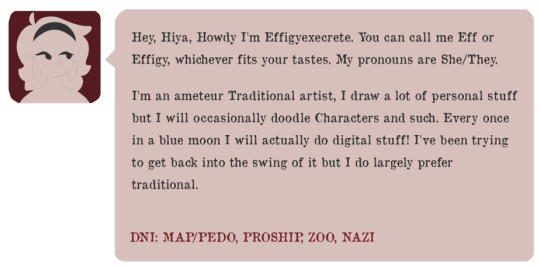
Interest List
Nine Inch Nails, Trent Reznor
Nu-Metal, Trad Goth music, Industrial, Industrial Rock, Industrial Ambient (starting to notice a theme here huh)
Silent Hill
Mad Max
Tank Girl (Both comics and film)
David Firth, Locust Toybox
Felix Congrave
Limbo Lane, Smile for Me
Ghost and Pals
Fran Bow
The Maxx
Crashbox
Brütal Legend
Alice: Madness Returns
Mega-List of Inspirations
David Firth, Neros Day at Disneyland, Trent Reznor, Felix Congrave, A Day in Hell (2003), Slitherbop, Plastiboo, Rob Zombie, BEAR*/BEAR™️ (Alpha), Jackbox Party Games "Trivia Murder Party" & "Fibbage", David Firth's "Crooked Rot", The Tender Cut (2014), House of a 1000 Corpses (2003), I Beleive in Unicorns (2014), Tesco Value (Czslaw Spiewa), Katarzyna Groniec, Isle of Dogs (2018), Grouper, Jack Stauber, HBO's "Crashbox", The Maxx, Brütal Legend, Alice: Madness Returns

DIRECTORY
Art Stuff Literally just the classic art stuff, highly recommend this if you are binging thru my stuff.
Date With Verne Selection The selections collected so far on "A Date With Verne" series here on Tumblr.
Live Effigy Status Radar My life on blog, whether it be little gags, genuine updates, or rambles.
#pinned post#pinned intro#pinned info#blog intro#small art blog#small art account#small artist#dni list#dni criteria
3 notes
·
View notes
Text
Muse: Gym Leader/Elite Four roster for BW3
-
A lot of talk of potential Unova remakes/progression lately. So, I just wanted to get some personal hopes/headcanon off my head and share a notion of Gym Leader/Elite Four rosters and where Unova is. No real stance on timeline progression, so I'll go for a generous take.
-
BW3 is set eight years after the events of BW2 and two years after the events of Indigo Disc. Unova has reaped the benefits on collaborating with Paldea in the Blueberry Academy. New innovations from manufactured Tera energy have allowed the region to instigate Terastallization in specialised structures (Gyms, PWT, etc) as well as introducing Paldean species in controlled reservations.
Our protagonist- let's say, Grey- resides in Castelia City. They're part of a prodigal artistic/battle facility overseen by Burgh. Burgh maintains his postion as Castelia's Gym Leader, though these days he's more interested in mentoring potential challengers and creative minds. Burgh acts as a mentor to Grey, encouraging them to take on the Gym Challenge and rise as Unova's newest champion.
Striaton Gym: Cilan, Cress and Chili
The Triplets have returned to their roles as Gym Leaders in addition to managing their restaurant chain. They are content to serve as the first challenge to new trainers, though expansions to their establishments allow for more dramatic battles.
Aspertia Gym: Cheren
Cheran continues tutoring at Aspertia Gym, whose has expanded its faculties to enable more effective battle studies. Taking pride in helping newcomers devise new strategies, Cheren will battle in each format- single, double, triple and rotation alike.
Virbank Gym: Roxie
Roxie's been advancing her musical career since BW2 and has become a prodigal voice of Unova. Virbank Gym has thus expanded into a far larger and more glamorous venue, hosting huge crowds and drawing in massive revenue for the city.
Driftveil Gym: Lacey
After graduating from Blueberry Academy, Lacey has taken up Clay's mantle as Driftveil's Gym Leader, allowing her father to concentrate on Unova's continual industrial ambition. Clay has remade Driftveil Gym into a Fairy paradise, allowing Lacey to graciously welcome challengers to take on her double battle experience.
Opelucid Gym: Drayton
Likewise leaving Blueberry Academy behind, Drayton resolved to reconcile with his grandfather over issues brought around by his failed years. While not losing sight of the fun of battling, Drayton seeks to establish himself as a powerful challenge for trainers.
Castelia Gym: Burgh.
After earning five badges, Grey returns to Castelia, where Burgh congratulates their efforts and allows them to challenge him for his badge. Grey emerges triumphant, and Burgh proudly directs them to the last two gyms.
Icirrus Gym: Brycen
Having achieved multiple accolades for his acting roles, Brycen has decided to take some time from the big screen, both renewing his role as Gym Leader and taking on directorial roles.
Milstraton Gym: Skyla
Milstraton airport has been expanding, and while Skyla has found less time for personal flights, she's been managing her business handily. Collaborating with her wife Elesa's pursuits, Skyla ensures Unova's integrity as a creative force.
The Elite Four
1. Elesa has proved amibitious in crafting a more dazzling image. Supported by her wife Skyla's revenue, she's taken charge of design in the Elite Four to create more glamorous and memorable battles.
2. Marlon's prodigal talent easily earned him a place on the Elite Four. While still carefree to a degree, he makes a formidable challenge.
3. Marshal laments that Caitlin, Shauntal and Grimsley has left for other pursuits, but resolves to continue his path as a mighty opponent for all challengers.
4. Iris felt the Elite Four a worthy occupation since stepping down as Champion. Between overseeing Drayton and supporting Drayden, she takes her role seriously but still finds the thrill in every battle.
-
And that's my dream scenario. May focus on teams/strategies later, but for now, what would you hope to see for characters in a hypothetical BW3?
#gym leader skyla#gym leader elesa#pokemon gym leader#skyla#pokemon#airplaneshipping#elesa#pokemon black and white#gym leader clay#pokemon elesa#pokemon skyla#lacey pokemon#gym leader drayden#gym leader burgh#gym leader cilan#gym leader cress#pokemon chili#gym leader marlon#pokemon iris#pokemon drayton#pokemon scarlet and violet#gym leader roxie#gym leader cheren#elite four marshal#gym leader brycen
6 notes
·
View notes
Link

0 notes
Text
THIS DAY IN GAY HISTORY
based on: The White Crane Institute's 'Gay Wisdom', Gay Birthdays, Gay For Today, Famous GLBT, glbt-Gay Encylopedia, Today in Gay History, Wikipedia, and more …

1791 – France (Revolution) is the first Western European country to decriminalize homosexual acts.


1882 – Karol Szymanowski, the Polish composer, was born (d.1937). In his autobiography, My Life and Loves, the pianist Artur Rubenstein speaks of his friendship with the important Polish composer, Karol Szymanowski, who was Gay. Rubinstein speaks of a wealthy friend and admirer who had invited the composer several times to visit Italy. "After his return," Rubenstein writes, "he raved about Sicily, especially Taormina. 'There,' he said, 'I saw a few young men bathing who could be models for [the famed lover of Hadrian] Antinous. I couldn't take my eyes off them.'" Rubenstein doesn't mention that Szymanowski had been visiting the isle of Wilhelm von Gloeden, and one wonders, in fact, and whether the German photographer was Szymanowski's wealthy friend.
Szymanowski was born to a wealthy land-owning family of the Polish gentry in the present-day Ukraine. From 1901 he attended the State Conservatory in Warsaw, of which he was later director from 1926 until retiring in 1930. Musical opportunities in Russian-occupied Poland being quite limited at the time, he travelled widely throughout Europe, North Africa, the Middle East, and the US.. These travels, especially those to the Mediterranean area, provided much inspiration to the composer and aesthete.
During these trips he also wrote poetry and his novel Efebos, parts of which were subsequently lost in a fire in 1939. He explored religious and homosexual themes in the novel and it was translated by him into Russian and given as a gift in 1919 to his partner Boris Kochno.


1976 – Carlo Masi is the screen name of Ruggero Freddi, an Italian mathematics lecturer, and former gay pornographic film actor.
Freddi was born in Rome in 1976 to a "poor" family. His parents divorced when he was three years old. At the age of 14, he began to work out at a local gym, practicing bodybuilding assiduously. In 2002, when he was about to complete his first cycle of study at the Sapienza University of Rome, he moved to Canada, and subsequently to New York.
In 2003, Masi completed a Master of Science (MSc) degree in computer engineering at the Sapienza University of Rome and worked in an artificial intelligence laboratory.
In 2004, after being contacted by a Colt Studio Group (CSG) recruiter, he made his debut in the gay pornography industry participating in his first porn movie, Big N 'Plenty. After his debut, he signed an exclusive model contract with CSG. He has always promoted safe sex, fraternising with the Italian LGBT community.
In 2006, he was selected to appear on the cover of COLT 40, a coffee table book published to celebrate the fortieth anniversary of the production company.
In 2007, Masi and his future husband, Adam Champ (Gustavo Leguizamon), were selected to appear on the cover of the Damron 2007 Men's Travel Guide.

In 2008, CSG and Calaexotic released a dildo reproduction of Masi's penis. That same year, he was named the first and only Colt Man Emeritus and his contract was extended to life time one. In 2008, Masi and Champ, were selected to appear on the cover of Adam Gay Film & Video Directory Magazine.
Following a disagreement with Colt in 2009, Masi retired from the pornographic industry.
After working in the theatre, Masi decided to return to the Sapienza University of Rome. There he earned a Bachelor of Science degree (cum laude) in mathematics, with a score of 110/110 and then a Master of Science degree (cum laude) in mathematics with a score of 110/110. In 2020, he completed a Ph.D. in Mathematical Models for Engineering, Electromagnetism and Nanosciences at Sapienza University of Rome focusing on the application of Morse theory to a Dirichlet problem traced back to Poisson equations.
In 2017, an article published by la Repubblica brought to light his past as a porn actor causing a media frenzy. The story was picked up by numerous newspapers around the world.
In 2015, he married Prince Giovanni Fieschi Ravaschieri Del Drago in Porto. In 2016, he became his widower.During his participation at Pomeriggio Cinque, an Italian news program, he proposed to his partner, Gustavo Leguizamon. The civil union was celebrated on May 4, 2018, and was broadcast live on Pomeriggio Cinque.

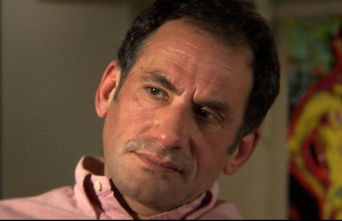
1955 – Richard Berkowitz is a gay American author and activist best known as an early advocate of safe sex in response to the AIDS crisis among gay men in the 1980s.
Berkowitz was born to Jewish parents and raised in New Jersey. While in college, he organized what he believes was the first gay rights protest in the state, demonstrating against an anti-gay effigy hung by the Delta Kappa Epsilon fraternity. After college, Berkowitz moved to New York City in 1978 or 1979, earning a living as a self-described S&M hustler.
Even before AIDS was recognized as a syndrome, Berkowitz became concerned about protecting his clients, many of whom were married, from sexually transmitted diseases. He met physician Joseph Sonnabend and became a patient, learning from Sonnabend the practices for risk reduction that would later become known as safe sex. His early work with Sonnabend and singer and activist Michael Callen noted behaviors including drug use, multiple sexual partners, and unsafe sexual practices in the gay community for transmission. These claims were considered controversial by early leaders of Gay Men's Health Crisis, such as Larry Kramer, and many activists took issue with the language of their message and its implications.
The 1983 pamphlet "How to Have Sex in an Epidemic: One Approach" by Callen and Berkowitz (in consultation with Sonnabend) is widely considered the first sex-positive guide to practicing safe sex.
Berkowitz himself tested positive for HIV in 1984 but was able to avoid taking any anti-viral drugs until 1995.
Berkowitz is the subject of the 2008 documentary Sex Positive directed by Daryl Wein and winner of the 2008 OUTFEST Grand Jury Prize for Best Documentary.

1967 - A New Mexico appellate court rules that cunnilingus is prohibited by the state's sodomy law.

1997 – Annie Proulx’s short story Brokeback Mountain is published in this week’s issue of The New Yorker. The story, later turned into a hit movie, depicts the complex romantic and sexual relationship between two men in the American West from 1963 to 1981. In 2007, the composer Charles Wuorinen approached Proulx with the idea of turning her short story "Brokeback Mountain" into an opera. The opera of the same name with a libretto by Proulx herself premiered January 28, 2014 at the Teatro Real in Madrid, to mixed reviews.


3 notes
·
View notes
Text
Maestro Movie Review
A portrait of Leonard Bernstein's singular charisma and passion for music as he rose to fame as America's first native-born, world-renowned conductor, following his ambitions to compose symphonic and popular Broadway musicals.
On November 14th, 1943, a young conductor and composer, Leonard Bernstein, substituted at the last minute to conduct the New York Philharmonic at Carnegie Hall. Since that fateful day, Leonard Bernstein has become a legend in the music industry as he is regarded as the first great American Maestro. Whose music will span for generations to come. Since his passing in 1990, many filmmakers have tried adapting his complicated life to the big screen. Even filmmakers such as Steven Spielberg and Martin Scorsese have passed on the project to hand it off to Bradley Cooper. Cooper has proven himself over the past decade that he is one of the best actors in the business, but a rising writer and director. So it came as a shock to me to see how simple Maestro was.
If you have seen any music-related biopic, then Maestro is going to feel very familiar as it follows the standard plotline of this genre. From the rise to the fall and the eventual redemption of said person, Maestro falls into all of the traps that plague the biopic genre. Thus causing the story, the characters, and their relationships to feel very surface-level and superficial. Leonard Berstein was a musical genius whose personal life was very complicated, yet the story portrays his life as a very simple matter. By the end of the film, we don’t understand what Leonard Bernstein and Felicia Montealegre were really like. Maestro never dives into Bernstein’s creative passion and what made him tick. Nor does it dive into his battle with his sexuality and how it affected his relationship with others, especially his wife. These essential biopic questions and many others are either entirely glossed over or vaguely touched on. And what further adds to my frustration is that the film acts a lot smarter than it is.
Now the reason why it feels smarter than it is is due to Cooper’s brilliant direction. Despite writing an average biopic script with writer Josh Singer, Cooper’s direction elevates this script to the next level. Cooper’s direction is brilliant as he further refines his directorial touch. He transports his audiences through the decades of Bernstein's life with his beautiful visual storytelling. The film starts as a black-and-white musical fantasy that is straight from the 1940s and 50s to highlight the youth and joy of Bernstein's early life. Then the film transforms into the lush but gritty technicolor allure seen in the 1960s and 70s to highlight the marital struggles between Leonard and Felicia. As the decades progress, so does the filmmaking style that Cooper utilizes. Furthermore, his utilization of long, uninterrupted takes just further immerses the audience into this story. Cooper has clearly shown great care in his craft while crafting this film, especially in the film's musical scenes. The recreation of Bernstein conducting the London Symphony Orchestra in Mahler’s “Ressurection” is an out-of-body experience. Then for the rest of the film, utilizing Bernstein’s musical composition to tell his life story is beautifully touching and personal.
Bradley Cooper and Carey Mulligan both gave some of the best performances of their careers in Maestro. The pair have impeccable chemistry on screen as they completely transform into their respective characters. Nailing all aspects of their characters from their mannerisms to their voices. We watch the pair go through all the trials of this very complicated relationship. From star-crossed-lovers to fiery fights, and heartbreaking diagnoses, they perfectly portray this couple's complicated life. Even though the material lacked the depth required to portray these characters properly, both were able to give their characters and their relationships some depth with their performances. However, despite being first billed, Carey Mulligan is sidelined in the film. I wished the film explored more of her perspective and her reaction to Leonard's constant cheating as he was a closeted bisexual/gay man. Mulligan elevates it as much as she can, but she is sadly left out to dry. The same can be stated for Cooper as there is no material for him to work with to show the internal conflicts of his closeted character. Both of them will easily earn an Oscar nomination but might miss the award because of how shallow their characters were written.
With Netflix providing the majority of the film's financial backing, you know that it will look good. The cinematography is breathtaking as it transforms in style as the decades progress in Bernstein’s life. From the classic black-and-white Hollywood looks of the 1940s to the technicolor of the 1960s, you will be immersed in this story. What further adds to the immersion is the impeccable production and costume design that is period-accurate. However, I am sad that they gloss over that Felicia was an influential fashionista during the mid-century.
I expected more out of Maestro than a standard musical biopic. Leonard Bernstein’s legacy will last generations, and to see his biopic play it safe is a little insulting. Especially when Lenny took massive risks in his musical career. This film has all of the elements of a masterpiece, but its safe and shallow script prevents it from achieving that status.
My Rating: B
#film#cinema#movies#movie#filmmaking#filmmaker#moviemaking#moviemaker#cinephile#cinematography#film community#film is not dead#film review#movie review#film critic#movie critic#maestro#leonard bernstein#bradley cooper#carey mulligan
3 notes
·
View notes
Text
Tag Directory
Theme Days
meme monday • tasteless tuesday • weird covers wednesday • sexy saturday
Genres
a cappella
classical • choral music • classical crossover
country • bluegrass
electronic • chiptune • darkwave • folktronica • industrial
dance • disco • eurodance
folk music • antifolk • filk • folk pop • freak folk • new age • psychedelic folk
folk rock • folk punk
hip hop • alternative hip hop • jazz rap • trip hop
jazz • swing
pop • alternative pop • art pop • baroque pop • bhangra • dance pop • electropop • experimental pop • indie pop • pop punk • pop rock • synthpop
jpop • alt idol
rock • alternative rock • cambodian rock • chamber rock • classic rock • emo • folk rock • indie rock • jrock • nerd rock • new wave • progressive rock • psychedelic rock • punk rock • stoner rock • surf rock
gothic rock • dark cabaret • deathrock
metal • doom metal • folk metal • gothic metal • heavy metal • melodic metal • pirate metal • power metal • symphonic metal
soul • neo soul
funk • funk rock
Soundtracks
anime soundtracks • movie soundtracks • musical theater • video game soundtracks
Miscellaneous
Christmas music • Eurovision • holiday music • mashups • remixes • singer songwriter • TikTok • weird music videos
3 notes
·
View notes
Text
Japanese rock legend Yoshiki to be honored with a handprint ceremony in Hollywood

TOKYO
Billboard dubbed him a “musical innovator” while Consequence wrote that he’s “one of the most influential musicians and composers in Japanese history.” Now, 57-year-old drummer, pianist, composer, and all-around inspirational artist Yoshiki has unlocked a new achievement by having his handprints and footprints immortalized outside of the TCL Chinese Theatre in downtown Hollywood.
Rising to widespread fame as the leader and co-founder of legendary Japanese rock band X Japan, Yoshiki has also gone on to have a successful and prolific solo career, performing in front of massive crowds at venues around the world. Outside of music, he’s also well-known for his contributions to film, fashion, his high-profile acquaintances, as well as everything from generous charitable acts to his Yoshikitty collaboration with Hello Kitty.
▼ Yoshiki sharing news of the honor on his X account

The ceremony on Thursday 14 marks a particularly momentous occasion as Yoshiki will be the first Japanese person ever to receive the honor out of roughly 300 pioneers in the entertainment industry whose handprints have been left outside of the Theatre since the tradition began in 1927. Other actors of Japanese descent such as silent film star Sessue Hayakawa (1886-1973), Japanese-American actor Mako Iwamatsu (1933-2006), and even Godzilla have been honored with stars on the nearby Hollywood Walk of Fame, but with over 2,760 of those, Yoshiki will join a much more exclusive club.
At the ceremony, his good friend Gene Simmons of the American band Kiss will be in attendance and his Korean actor friend Byung-hun Lee is slated to be a guest speaker. His first directorial work, a long documentary film titled "Yoshiki: Under the Sky," is also set to have its Hollywood premier at the TCL Chinese Theatre on the same day.
Finally, fans of Yoshiki have even more reason to celebrate as the musician will be kicking off his Yoshiki Classical 10th Anniversary World Tour with Orchestra 2023 “Requiem” in Tokyo beginning on October 7. We wish him all the best as he embarks on this new journey in Japan, followed by stops in London, Los Angeles, and New York. https://soranews24.com/2019/12/13/yoshiki-makes-surprise-appearance-at-kiss-concert-in-tokyo-【video】/
2 notes
·
View notes